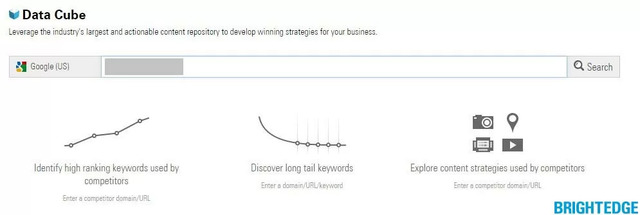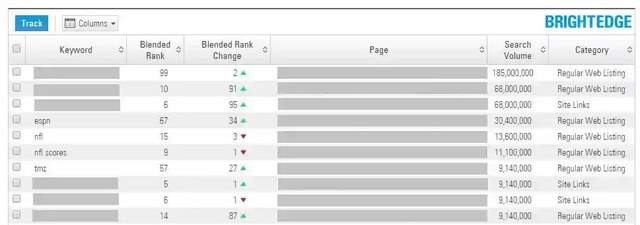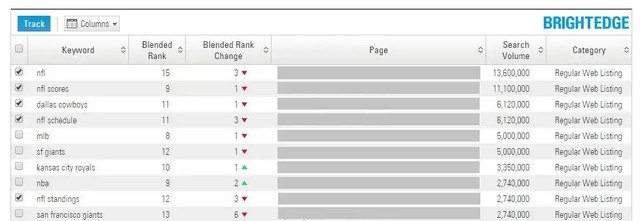The SEO landscape is always changing – algorithm updates, a shifting competitive landscape – but one thing remains consistent: the need for data-informed keyword research. When done properly, keyword research can expand keywords and produce insights into your market, your competitors’ performance and demand for your product or service.
How we start keyword research and expand keywords at BrightEdge
When one of our customers initially joins BrightEdge, they go through a six-week Onboarding Process in order to “learn the BrightEdge platform, identify goals and work through an Ignite project.” On occasion one of our partners will start Onboarding with a small number of keywords that they want to track. While this is a fine way to start, one of the jobs of the Customer Success team is to build out that initial set of keywords and maximize feature usage and value, so they are on the path to SEO success. Enter BrightEdge’s Data Cube and Striking-Distance Project.
Utilizing the industry’s largest data set to expand keywords and drive keyword research
Launched in March of 2014, the Data Cube “consists of billions of pieces of data, including content, rich media, search terms, and social signals - all at Internet scale - to provide companies with the insights they need to make strategic business decisions.” If you don’t know where to start with keyword research, our recommendation is to always start with the Data Cube. You can focus at the macro-domain level, at the keyword-level or even with one of your category pages. Typically, we will start with a Striking-Distance Project, which in effect looks for low-hanging fruit or keywords within “striking distance” of the first 5 rank positions.
Here’s how it works
First, let’s take into consideration your business objectives. For example, let’s say you want to focus on a category of your site that receives a moderate amount of traffic and has seen increased competition lately. In that case, you would simply enter the URL into the Data Cube and click “Search”.

You will then have the option to drill down into BrightEdge’s vast repository of keywords that are driving users to your category page and all of the pages nested underneath it.

However, since the Data Cube contains such a large data set, some filtering is usually in order. The best place to start is usually filtering out branded terms; this allows you to focus on the higher-priority, non-branded terms that your competition is also targeting. The next step is to focus on keywords that fall within a certain a range, for example, between positions 5 and 20 (i.e., below the fold on page 1 and to the end of the second page). Next, ensure that you’re only focusing on keywords with a sufficient amount of Search Volume. So the last filter is “Search Volume Greater than 1000”.
For a detailed walkthrough on determining the breadth and scope of your keyword strategy, check out our How Many SEO Keywords Should I Manage? video tutorial

This should provide you with the beginning of a short (or, rather long) list of keywords to sift through for relevance and immediately start tracking. Thankfully, that’s as easy as clicking the checkbox on the left of the keyword, and adding it to a keyword group.

Summing it up
At BrightEdge, the Striking Distance Project is a staple of our partners’ success. Utilizing the Data Cube and the simple workflow built into the platform, our partners are able to quickly cut down the amount of time it would take to do a similar project without BrightEdge. In fact, if you calculate the time it would take to complete each of the steps to expand keywords: keyword research (on average, 5-10 hours), optimize your site (on average, 5 hours) and report on progress (on average, 10 hours), with BrightEdge this project for marketing efforts can be done in half the time or less!
Our partners have had great success with the Striking Distance Project for a number or reasons. First, it is the perfect way to become familiar with the platform and the easy-to-use workflow our product and engineering teams have built. Second, by optimizing for keywords that your site is already ranking well for, you can see results much faster than you would by focusing on keywords that are ranking on pages 3 and beyond. Finally, it’s common knowledge that the first five results in Google have the highest click-through rate. By optimizing keywords and pages you are already ranking well for, you will increase your ability to rank better in Google, thereby increasing traffic, conversions and revenue.
When this occurs, the Customer Success team at BrightEdge has fulfilled its task of making our partners look like “rock stars” in their organization while at the same time saving them time. From a Customer Success perspective, that’s a win-win and why we come to work every day.

